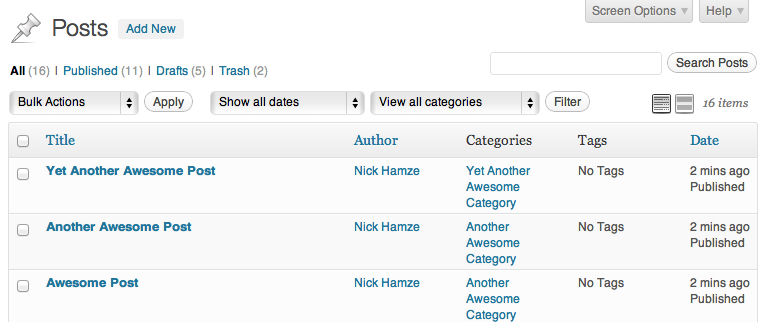To edit your blog’s posts, click the Posts menu in your dashboard.

You’ll see something like this:

You can filter Filters are one of the two types of Hooks https://codex.wordpress.org/Plugin_API/Hooks. They provide a way for functions to modify data of other functions. They are the counterpart to Actions. Unlike Actions, filters are meant to work in an isolated manner, and should never have side effects such as affecting global variables and output. the posts displayed using several methods. The first method is using the links at the top of the screen.

You may also see Private and Pending Review links.
The next method is using a search.

The final filtering method is to use the date and category The 'category' taxonomy lets you group posts / content together that share a common bond. Categories are pre-defined and broad ranging. dropdown boxes and then click on the Filter button.

There are a couple of ways to remove posts from the Posts screen. If you want to trash Trash in WordPress is like the Recycle Bin on your PC or Trash in your Macintosh computer. Users with the proper permission level (administrators and editors) have the ability to delete a post, page, and/or comments. When you delete the item, it is moved to the trash folder where it will remain for 30 days. multiple posts at once, you can check the boxes to the left of each post, select Move to Trash from the Bulk Actions dropdown, and click Apply.

If you only want to trash one post, place your cursor over the post, and a few action links will appear under the post’s title. Click the Trash link.

To restore a post that you’ve trashed, view your trash by selecting the Trash link near the top of the page. Hover over the title of the post you want to restore and click Restore. This will move the page back to your Posts menu. You can restore multiple posts at once using the Bulk Actions dropdown.

To permanently delete a post, view your trash by selecting the Trash link near the top of the post. Hover over the title of the post and click Delete Permanently.

To permanently delete all your trashed posts, go to your trash and click Empty Trash.

The Quick Edit option will appear below a post title when you hover over the title. Quick Edit lets you modify the post details such as title, slug, date, author, password, privacy, categories, tags, comments, status, and sticky.

Using the Bulk Actions drop-down menu at the top of the Edit Posts list, you can bulk edit several posts at a time. To do that, select several posts from the list using the checkboxes on the left. Then select Edit from the Bulk Actions drop-down menu and click the Apply button. You will see options that can be applied to all of the selected posts.

Note: There currently isn’t a way to bulk edit multiple posts to switch the status from Password Protected to Public.
You can show an excerpt An excerpt is the description of the blog post or page that will by default show on the blog archive page, in search results (SERPs), and on social media. With an SEO plugin, the excerpt may also be in that plugin’s metabox. of each post in the list by using the Excerpt View button above the list.

When you make the change, a post row will now show some of the content from the post.

By using the Screen Options pull down at the top right of the screen, you can show/hide the columns displayed on the Edit Posts Screen. See Screen Options for more information.







